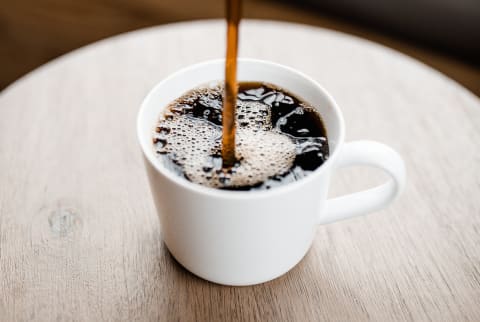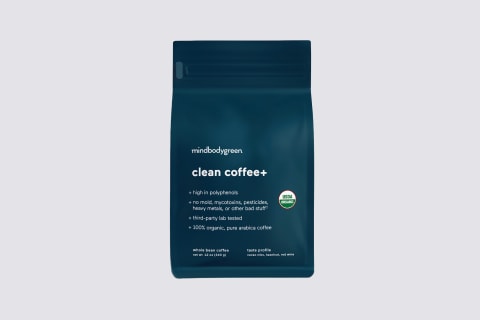Advertisement
Arabica vs. Robusta: Is One Better For Flavor & Health Benefits?


Coffee is a nonnegotiable morning staple for billions of people worldwide. If you fall into this category, your first question of the day isn't "Am I having coffee?" it's "What kind of coffee should I drink today?" Before you choose between drip coffee, lattes, or cold, you should first be thinking about the type of coffee bean to use.
Don't fret if this isn't something you've pondered before. Even as a dietitian, the first time I learned about coffee bean varieties was at a coffee farm in Colombia last year that grew 100% arabica coffee beans. After learning more about the quality, cultivation, and roasting of the beans and tasting the coffee's superiority, it has since become my go-to choice compared to the other common bean variety—robusta—for my morning brew.
And hopefully after reading this, you'll see why.
All coffee has some general characteristics
Coffea (commonly shortened to coffee) are flowering, small trees that are grown in tropical regions—and at high altitudes1—around the equator. The coffee cherry has to be picked, processed (to expose the coffee bean), dried, and then roasted. That leaves us with whole beans that are ready for grinding and brewing.
There are over 124 species of coffee, but most of the coffee we consume today comes from just two varieties: arabica and robusta. Now, all coffee is a natural source of caffeine, sugar, oils, phenolic acids, and antioxidants. However, there are innate differences between the composition of these compounds in arabica compared to robusta that ultimately impact the flavor and even the health profile of the final cup.
Here's what you can expect from a cup of arabica coffee
Arabica is known for having a more elegant and complex flavor than robusta coffee. Here's why:
- Arabica beans have fewer bitter compounds: Two of coffee's main compounds (caffeine and chlorogenic acids) are naturally bitter. Arabica beans naturally have slightly less of these compounds, which may contribute to a smoother, milder, and less astringent taste.
- Arabica beans are more rich in oils: These beans have about 60% more total oils compared to robusta. Beans with higher oil content are known to have a more pleasing smell and taste thanks to the richer and almost creamier sensation in your mouth.
- Arabica beans have fewer amino acids: Reduced amino acid (the building blocks of protein) content in coffee beans contributes to a smoother, lighter body and a more velvety cup of coffee than robusta.
- Arabica beans have a higher acidity: Higher acidity than robusta may sound undesirable, but it's not. The higher acidity of arabica beans allows for a certain layer of brightness—that balances out the other bitter and sweet profiles of the bean's other compounds.
Because of these differences, the taste of arabica coffee has long been regarded as superior to robusta. As more folks consider themselves to be coffee connoisseurs and seek out the best product on the market, awareness and demand for arabica coffee has skyrocketed.
This public attention has pushed a certain level of sustainability practices and quality control practices across the arabica coffee industry (not the robusta industry).
Pure arabica coffee tends to also be more expensive than robusta coffee—not only because of the quality control factors listed above but because it's a higher and more particular resource-intensive product than robusta.
Overall, when you make coffee with 100% arabica beans, you can pretty much expect to have a well-balanced, flavorful cup.
These are the typical characteristics of robusta coffee
Robusta coffees often have a more bitter, earthy, or rubbery taste2 that can be attributed to their chemical profile.
Robusta coffee is also more prone to having defects such as mold or insect damage. But these aren't inherent to the coffee species itself, and these defects could actually be remedied with the right quality control measures in place. Since robusta coffee has long played second-fiddle to arabica, there hasn't been a substantial industry-wide motivation to improve it.
So it's definitely possible to find a high-quality cup of robusta coffee (and some people really do prefer the taste of it), but it's not likely without a substantial amount of homework on your end.
Is one more nutritious?
Coffee is actually one of the most studied plants (like, ever). Research has shown that drinking coffee—especially black coffee—is linked to a slew of health benefits. It supports heart health3, protects the brain from cognitive decline4, promotes a healthy and diverse microbiome5, and can even rev up your metabolism—all while, of course, enhancing your alertness.
From a nutritional perspective, coffee derived from these two species is pretty similar. However, the roasting and brewing method of the coffee can impact the amount of antioxidants you get from it.
Coffee is a rich source of antioxidants. In fact, it's the largest contributor of antioxidants6 to America's diets. Too much heat can lessen the antioxidant content of beans, so light to medium-roast coffees tend to have more antioxidants than beans that are dark-roasted.
Arabica beans are often light to medium roasted to help preserve their delicate and nuanced flavor. Robusta beans are often dark-roasted. This helps to mellow the bitterness from the higher caffeine content and mask some of the undesirable flavors and impurities that come with lower-grade robusta beans.
So, a light or medium roast7 may provide you with more beneficial antioxidants. But the brew method also impacts antioxidants. Filter brews8 like drip, pour-over, or cold brew produce a product with stronger antioxidant activity than an espresso.
So, what kind of coffee should you drink?
Choosing 100% arabica coffee beans is your best route to brewing a high-quality, smooth cup of joe every time.
But if you want even more assurance, opt for mindbodygreen's clean coffee+. This handcrafted premium blend provides whole, organic arabica coffee beans, sustainably sourced from Africa, Indonesia, and Latin America.
And while arabica coffee growers have their own quality control measures in place, clean coffee+ undergoes even more comprehensive, third-party lab testing in the U.S. for heavy metals, yeast, mold, bacteria, mycotoxins, acrylamide, pesticides, and solvents. We also test for caffeine content, theobromine, and polyphenols to give you the most detailed view possible of your favorite beverage of the day.†
And with a smooth body and notes of hazelnut, red wine, and chocolate, this blend will surely please your palate too.
The takeaway
If you're looking to step up your coffee game, make sure you're choosing beans from arabica coffee plants. Robusta beans are typically lower quality and have a bitter taste, whereas arabica beans are known for their brightness. Opt for whole arabica beans when possible (for maximum freshness), like mindbodygreen's clean coffee+.
8 Sources
- https://www.sciencedirect.com/science/article/pii/S1995764516304680?via%3Dihub
- https://pubmed.ncbi.nlm.nih.gov/33233244/
- https://www.sciencedirect.com/science/article/abs/pii/S0033062018300392?via%3Dihub
- https://pubmed.ncbi.nlm.nih.gov/34867277/
- https://www.ncbi.nlm.nih.gov/pmc/articles/PMC7282261/
- https://www.sciencedirect.com/science/article/pii/S0022316623026755
- https://pubmed.ncbi.nlm.nih.gov/33282263/
- https://www.sciencedirect.com/science/article/abs/pii/S0308814606004304
